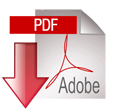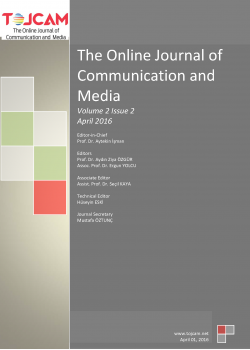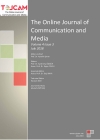TOJCAM - Volume 2 - Issue 2 - April 2016
 CAVIT ORHAN TÜTENGIL’S CONTRIBUTIONS TO THE FIELD OF COMMUNICATION STUDIES
CAVIT ORHAN TÜTENGIL’S CONTRIBUTIONS TO THE FIELD OF COMMUNICATION STUDIES Elif Küçük Durur
Abstract:
The history of communications studies in Turkey does not date back to very old times. Just like in many countries, the field of communication studies in Turkey had contributions from the other fields of sociology and a literature has been constructed based on these studies. From this point of view, it is necessary not to ignore the fact that many intellectuals from different disciplines have carried out communication studies on a field, which had not yet been named, decades before producing studies specific to the field as of 1980s. Among the intellectuals mentioned within this context, Cavit Orhan Tütengil’s contributions to the field of communication studies constitute the subject of this study. It is considered that this study will make significant contributions to the literature by revealing Tütengil’s unrecognized contribution in the history of communication studies in Turkey by looking at his works.
 DISCUSSING THE NEW AUDIENCE IN TURKEY IN THE EXAMPLE OF UNIVERSITY YOUTH: AN AREA STUDY
DISCUSSING THE NEW AUDIENCE IN TURKEY IN THE EXAMPLE OF UNIVERSITY YOUTH: AN AREA STUDY ADEM YILMAZ
Abstract:
Change of point of view related to visual quality has made explicit the intervention and participation of the audience towards technological developments and cultural structures revealed by the change in technology. The new audience has become an identity which sends limited messages to a homogenous audience in temporal terms, gives feedbacks to TV channels, beyond the individual displaying an active cognition towards the message; transforming his targets of previous periods due to numerous messages and resources into the power of interpretation, choosing his own messages, pointing out the subjectivities between the sender and the receiver by separating from the whole. For that reason, in this study, by looking through the perspective of the audience answers have been looked for about how they received broadcast contents of a new generation born into a commercial and thematic broadcasting especially after 1990, around which contents they contrite on, from which aspects they differentiate from the traditional audience. The questionnaire which has been prepared within the scope of an area study towards the crowd called “New Audience” has been applied and their tendencies have been pointed out.
 EURIMAGES MEMBERSHIP AND TURKISH CINEMA
EURIMAGES MEMBERSHIP AND TURKISH CINEMA İrfan Hıdıroğlu
Abstract:
Cinema-State relationship in Turkey until 1990s developed mostly around the issues of censorship and taxes. Neo-liberal economic and cultural politics after 1990s caused crucial breakups for the future of Turkish cinema. Turkey, on the one hand, organized a series of regulations in order for the free circulation of international capital and enabled Off-Shore Media Project in cinema through those regulations. On the other hand, the country became a member of international programs and institutions such as Eureka, MEDEA, See Cinema Network which were organized within the scope of European Union cinema politics, and carried forward its relationship with Eurimages. Eurimages membership caused a transformative effect in Turkish cinema in terms of economy, culture and art. Eurimages membership can be described as a new era of Turkish cinema or a moment when the country had an opportunity to rediscover itself. In this study, economic, cultural and artistic gains that Turkish cinema acquired thanks to Eurimages will be discussed. Besides, suggestions on how those gains can be carried forward in the future will be given.
 REALISTIC PRESENTATION OF VIRTUAL CHARACTERS IN MOTION PICTURES
REALISTIC PRESENTATION OF VIRTUAL CHARACTERS IN MOTION PICTURES YĂĽksel BALABAN
Abstract:
Reality concept has a crucial significance in the movies as well as in the other fields of art. In the movies, the identification of the audiences with the characters, and their believing what they watched are some of the reasons underlying this reality. On the one hand, the incidents happening in the imaginary world might take its audiences to the place where wanted and on the other hand they might convey the message that is desired. In the creation of reality with the development of technology, what is watched for an audience is getting more and more believable. Both the development of the technology in the movie theatres such as the use of the anaglyph spectacles and the improvements of the film production techniques support the creation of the reality in the movies.
In this study, the contribution of virtual characters used in the movies to the reality of the film is going to be examined. Even though audiences do not live in real terms, they perceive the characters within the integrity of the film with the other characters in the real life. Thanks to the developing technology, virtual characters have become inseparable from real performers. In order to the realistic appearance of these characters, some technical specifications need to be gathered. At the end of some stages having different kinds of difficulties, the characters reach their final appearances. However, the reality in here is not a concept that is going to be discussed with its unique feature. Aforesaid reality is the reality having a different structure with a good deal of features. In the realistic presentation of a character, there are a lot of features completing each other such as its acting within the context of its design, dubbing, and movements.
In the study, virtual characters used in the films at present which are created in computers are going to be discussed. Then, the features underlying the realistic performances and appearances of these characters are going to be presented. These simulated characters depended on the imitation of reality are going to be evaluated in terms of Baudrillard’s Simulation Theory. The paradox being caused by the believable influence of characters on the audiences which are not real in spite of having all the features of reality as in the simulation causes is going to be demonstrated in this study.
 THE IMPORTANCE OF CREATING LOCAL-CULTUREL SYMBOLS IN THE PROCESS OF CREATING DESTINATION BRAND: EXAMPLE OF ESKÄ°ĹžEHÄ°R CITY
THE IMPORTANCE OF CREATING LOCAL-CULTUREL SYMBOLS IN THE PROCESS OF CREATING DESTINATION BRAND: EXAMPLE OF ESKİŞEHİR CITY Mustafa Özgür SEÇİM
 THE OPINIONS OF HIGH SCHOOL STUDENTS REGARDING ENERGY AND ITS PROBLEMS
THE OPINIONS OF HIGH SCHOOL STUDENTS REGARDING ENERGY AND ITS PROBLEMS Esra ÇAKIRLAR, Salih Levent TURAN
Abstract:
Energy is an element that we need in every aspect of our lives. Especially because of reasons such as growth of population and increase of life standards, technological advances, industrialization need for energy has increased very much. The necessity of considering energy supplement safety, providing source variety as well as environmental effects in choice of energy sources comes forth.
In this study, by using qualitative research techniques, it is aimed to determine the opinions of the secondary school students, being the adults of the future, about energy issues as the energy is indispensable part of our lives. In line with this purpose, as a tool of data collection, a semi-structured interview form, developed by researchers by taking into consideration the secondary education curricula, is used and it took it’s final shape in accordance with expert opinions. The semi-structured interview form is applied to 32 students who take education at different Anatolian High Schools. By the analysis we did in light of this study some advices about energy and environmental education have been pointed out.
 TWITTER AS A MEANS AND FORM OF COMMUNICATION
TWITTER AS A MEANS AND FORM OF COMMUNICATION H.Hale KUNUCEN
Abstract:
Twitter, which is a medium of communication, a social network and a micro blog site, can also be defined as an information/knowledge-sharing platform. The most prominent feature of this new generation platform is its hundred and forty character limitation. The departure point of this study is that this distinctive character limitation which separates Twitter from other social media platforms, i.e. Twitter’s format, also determines the form in which information/knowledge is shared. This descriptive study aims to examine Twitter as a means of communication and a form of communication within the framework of precise, striking, “headline style” posts that come about due to the limited space. Impossibility of observing the sine qua non 5w 1h rule due to the said limitation compels the news providers to use the available space in the most efficient way possible. In other words, the structural limitation imposed by Twitter prompts the users to present the content in an effective and striking manner. In this study, positive and negative effects of Twitter’s character limitation on news transmission will be put forth.


